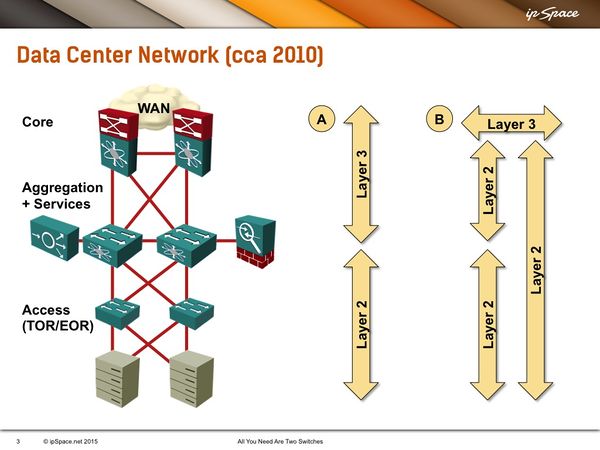Building Next-Generation Data Center
Optimize Your Data Center Infrastructure
ipSpace.net » Documents » Optimize Your Data Center Infrastructure
Many enterprise data centers built today don't need more than two switches making the data center fabric discussions, and detailed comparison of vendor-specific fabric architectures and features quite unnecessary.
As always, you might be an exception to that statement. You might have more than a few thousand virtual machines. You might have very large Hadoop clusters. You might have some other enormous workloads like SAP HANA databases or huge Oracle database clusters, so there might be reasons why you’d need larger data center networking fabric. However, most of the customers I’ve met in the last 5+ years didn’t need more than two last-generation data center switches even though they were usually not aware of that.
A Brief Glimpse into History
Until approximately 2010 we’d recommend data center network infrastructure similar to the one shown in the following picture:
The data center switches we used in those days were an order of magnitude less capable than what we have today. They also had lower port counts forcing us to build networks in three layers: core, aggregation, and access. We simply couldn't connect everything to a core switch.
Making the design even more complex, we usually had to discuss the boundary between layer-2 forwarding (bridging) and layer-3 forwarding (routing) and whether we should extend a single VLAN across the whole data center and have layer-3 functionality only in the core, or keep bridging contained within the access layer with the L2/L3 boundary on the aggregation layer.
In existing large data centers you’d usually see three solutions to this challenge:
- Routing in the core network (including uplinks on aggregation switches) and bridging contained within the aggregation layer or
- Routing on core switches with bridging stretched across the core.
- Bridged data center networks with routing on network appliances (firewalls or load balancers).
Regardless of the L2/L3 boundary, traditional data centers often had three layers and plenty of switches, and even though you could see a data center where everything was connected to a pair of Catalyst 6500s, these were usually the smaller customers.
Using Modern Data Center Technologies
Using modern technologies and aggressive virtualization we can get rid of most data center infrastructure, and build the physical infrastructure you need with just two switches following a few easy-to-understand steps.
This article describes how you can get to that final goal in a series of steps:
- Virtualize the servers
- Stop using legacy technologies
- Reduce the number of uplinks per server
- Use distributed file system
- Virtualize network services
- Build an optimized fabric with two switches

